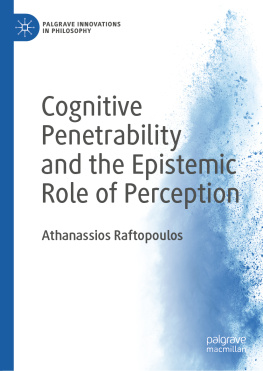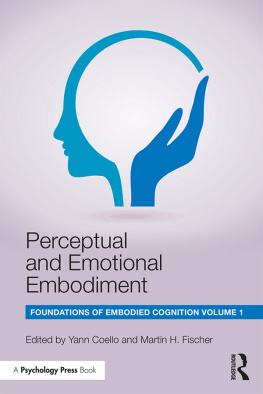SEEING THINGS AS THEY ARE
A Theory of Perception
John R. Searle


Oxford University Press is a department of the University of Oxford. It furthers the Universitys objective of excellence in research, scholarship, and education by publishing worldwide.
Oxford New York
Auckland Cape Town Dar es Salaam Hong Kong Karachi Kuala Lumpur Madrid Melbourne Mexico City Nairobi New Delhi Shanghai Taipei Toronto
With offices in
Argentina Austria Brazil Chile Czech Republic France Greece Guatemala Hungary Italy Japan Poland Portugal Singapore South Korea Switzerland Thailand Turkey Ukraine Vietnam
Oxford is a registered trade mark of Oxford University Press in the UK and certain other countries.
Published in the United States of America by
Oxford University Press
198 Madison Avenue, New York, NY 10016
Oxford University Press 2015
All rights reserved. No part of this publication may be reproduced, stored in a retrieval system, or transmitted, in any form or by any means, without the prior permission in writing of Oxford University Press, or as expressly permitted by law, by license, or under terms agreed with the appropriate reproduction rights organization. Inquiries concerning reproduction outside the scope of the above should be sent to the Rights Department, Oxford University Press, at the address above.
You must not circulate this work in any other form, and you must impose this same condition on any acquirer.
Library of Congress Cataloging-in-Publication Data
Searle, John R.
Seeing things as they are : a theory of perception / John R. Searle.
pages cm
Includes index.
ISBN 9780199385157 (hardcover : alk. paper)
ebook ISBN 9780199385171
1. Perception (Philosophy) I. Title.
B828.45.S425 2014
121'.34dc23 2014007473
1 3 5 7 9 8 6 4 2
Printed in the United States of America
on acid-free paper
For Dagmar
Contents
I want to thank all of the people who affected my production of this book: Ned Block, Tyler Burge, John Campbell, Jennifer Hudin, Jeff Kaplan, Mike Martin, John McDowell, and Umrao Sethi. For a relentless criticism of the intellectual content, I thank Klaus Strelau. Thanks also to my Research Assistants Mei Mei Yang, Nicole Badovinac, and Xia Hwang. Special thanks to Jennifer Hudin for the index. As usual my greatest debts are to my wife, Dagmar Searle, and I dedicate this book to her.
SEEING THINGS AS THEY ARE
This book is about perception. Like most authors who write about this subject, I will concentrate on vision. And though I did not intend originally to produce such a book, in a large part it is a celebration of visual experience. Along with sex and great food and drink, visual experience is one of the major forms of pleasure and happiness in life. There are other such things we take for granted that are sources of enormous pleasure if we bother to think about them: free bodily movement and the power of speech, for example. Along with visual experience, we take all of these for granted and so do not appreciate them as much as we do other sources of intense sensory pleasures.
I want to begin by identifying the territory. Close your eyes and put your hand over your forehead, covering your eyes: you will stop seeing anything, but your visual consciousness does not stop. Though you do not see anything, nonetheless you have visual experiences which are something like seeing darkness with yellow patches. Of course you do not see darkness and yellow patches, because you do not see anything; but you still have visual consciousness. The area of visual consciousness is quite constrained: In my case, it extends, roughly speaking, from the top of my forehead down as low as my chin. I am here speaking about the phenomenology and not about the physiological forehead and chin. I am talking about how it seems to me consciously. But the area of my visual consciousness is limited in that, for example, I have no visual consciousness behind my head or under my feet. But I definitely have visual consciousness in front of my face even with my eyes closed. That conscious area I just identified I will call the subjective visual field. Open your eyes and suddenly the subjective visual field is full, and the reason it is full is that you become visually aware ofthat is, you literally seethe objective visual field: the objects and states of affairs around you. Much of this book is about the relationship between the subjective visual field and the objective visual field. The most important point I can make right now is: in the objective visual field everything is seen or can be seen, whereas in the subjective field nothing is seen nor can be seen.
Why write a whole book about perception? The relationship between perceptual experiences and the real worldof which vision is the most important type of experiencewas a major preoccupation, one may even say the major preoccupation, of Western philosophy for the three centuries after Descartes. Up to the twentieth century, epistemology was the center of philosophy and the mistakes that defined the field continue right up to the present time. This book will attempt both to remove the mistakes and to present an alternative account to those I am familiar with, both traditional and contemporary. I hope to provide a more adequate account of the relationship between perceptual experience and the objects of our perceptions.
I want to say a little bit about how this book fits into my earlier work. After I published an intentionalistic account of perception in Intentionality, And I tried to explain the presentational intentionality of perception in ways that would enable us to see the logical structure of perceptual experiences. Such experiences, without being linguistic, present an entire state of affairs. They are causally self-reflexive. They are above all presentational rather than representational. (Please do not worry if you do not understand the jargon of causally self-reflexive, presentational, and representational. I explain all of these terms in due course.)
There were some unclarities and incompleteness in my account. For example, a persistent misunderstanding was that my account made perception too complicated for animals to grasp. But of course the claim is not that animals think all this high-level analysis, but that the analysis simply describes what is going on in their experience. When they perceive something, they actually perceive it only if the object perceived causes the very perception of it. As an analogy of this point: if I say knowledge is justified true belief that avoids the Gettier counterexamples and I say, my dog knows that someone is at the door, I am not thereby committed to the view that the dog is thinking, I have justified true belief that avoids the Gettier counterexamples. It is an old mistake to suppose that if animals can think, then they must be able to think that they are thinking. And it is an extension of that mistake to suppose that if animals have complex intentional structures in perception and action, then they must be able to think about the content of these complex intentional structures.
A second misunderstanding was that when I said that perception is causally self-referential, I might be saying that the perceptual experience performs some kind of a speech act of referring to itself. I intended nothing of the sort. The idea is that the conditions of satisfaction of perceptual experience require that the state of affairs perceived functions causally in producing the perceptual experience. So the conditions of satisfaction require reference to the experience itself. And in that sense the experience is causally self-referential. To avoid this misunderstanding I now use the expression causally self-reflexive instead of causally self-referential, but I intend the two expressions to mean exactly the same thing.












